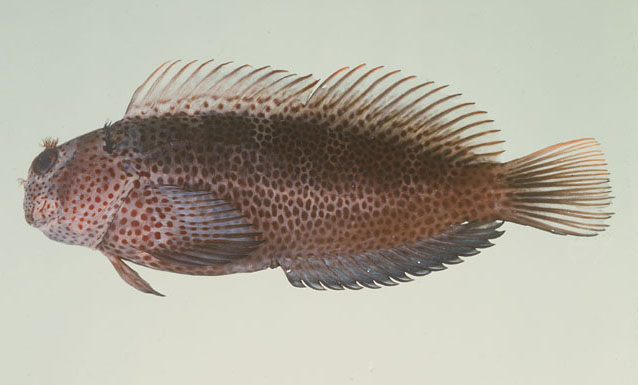| Blenniidae (Combtooth blennies), subfamily: Salariinae |
| 10.7 cm SL (male/unsexed) |
|
demersal; marine; depth range 0 - 8 m |
| Western Indian Ocean: known only from Mauritius and Cargados Carajos Shoals. Recently reported from Reunion (Ref. 53568). |
|
Dorsal spines (total): 12-12; Dorsal soft rays (total): 14-15; Anal spines: 2-2; Anal soft rays: 15-16; Vertebrae: 30-30. Diagnosis: Dorsal fin XII, 14, membrane attached to caudal fin, with deep notch above last spine, first spine about equal to second; anal fin II, 16; pectoral rays 15; pelvic fin I, 4; caudal fin procurrent rays 10-12. Vertebrae 10 + 20. Last epipleural rib modally on vertebral centrum 19. LL, without scales and scalelike flaps; LL tubes 1-7, canal ends on caudal-fin base. Lower lip smooth mesially, plicate laterally. Upper lip crenulae 36-43. Gill rakers 26-27. Cephalic sensory pore system complex, no pores at the extra interorbital position. Midsnout pores present. Cirri, supraorbital 12-26, nasal 10-18; nuchal cirri 36-42, in 4 groups, ventralmost group borne on a slightly expanded flap. Body spots, extending to basal half of dorsal, anal and caudal fins in females but not in males (Ref. 529). |
| Adults occur on coral patches in surge channels of rocky reefs with light surf, 0-8 m deep (Ref. 529). Oviparous. Eggs are demersal and adhesive (Ref. 205), and are attached to the substrate via a filamentous, adhesive pad or pedestal (Ref. 94114). Larvae are planktonic, often found in shallow, coastal waters (Ref. 94114). |
|
Least Concern (LC); Date assessed: 24 March 2009 Ref. (130435)
|
| harmless |
|
Source and more info: www.fishbase.org. For personal, classroom, and other internal use only. Not for publication.

